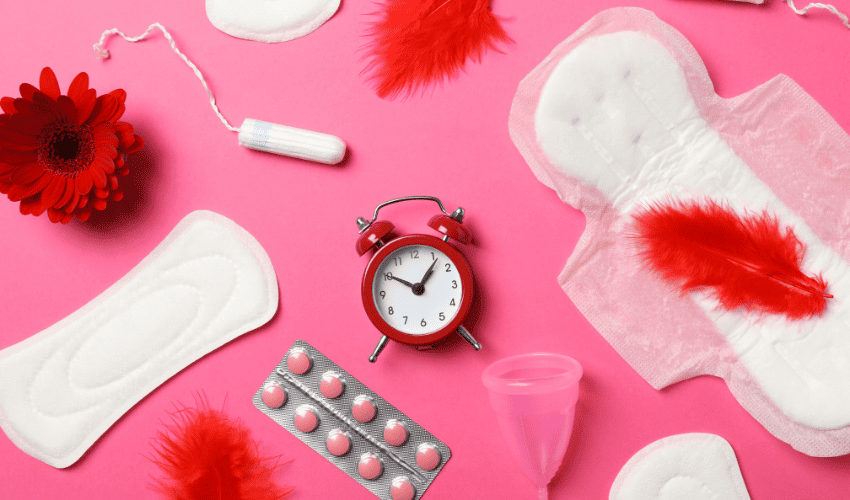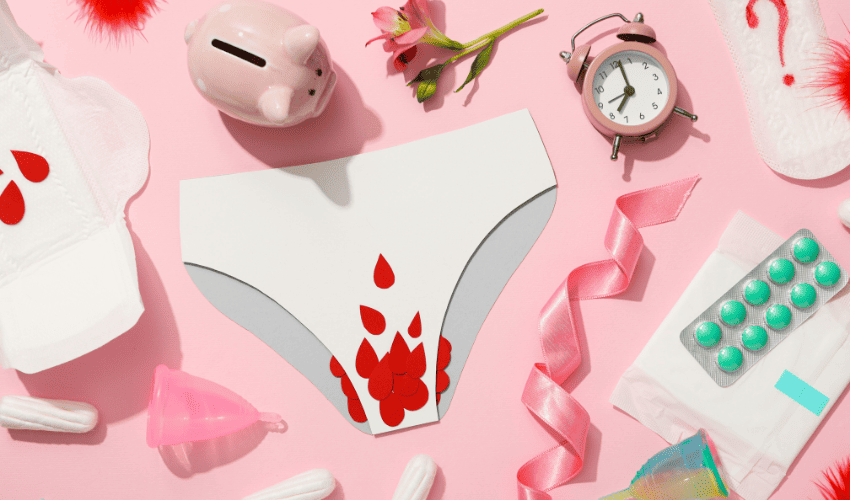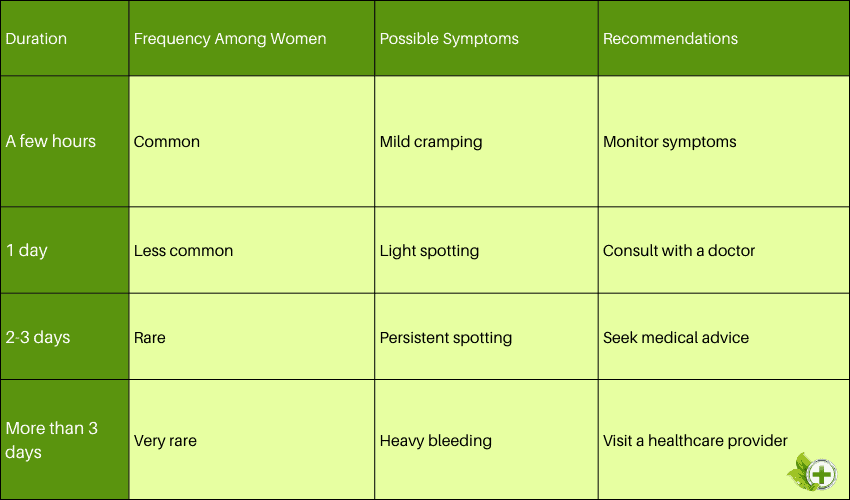Quick Reference
What Is Ovulation Bleeding?
Ovulation bleeding is light bleeding that sometimes occurs when an egg is released from the ovary (ovulates). Some women mistake ovulation bleeding for a period, but it's usually much lighter and shorter than a regular period. The blood flow is usually pink or brown in color and causes no pain or discomfort.
Why Does Ovulation Bleeding Occur?
Ovulation bleeding results from an egg's release from the ovary, which breaks a small blood vessel and causes spotting. Furthermore, this event triggers hormone fluctuations in the body as well.
How Does It Last?
Usually lasts for around 2/3 days. But can vary from woman to woman.
Ovulation Bleeding Symptoms:
- Cramping on one side of the abdomen (ovulation pain)
- Pelvic pain
- Breast tenderness
- Increased sex drive
- Changes in basal body temperature
- Lightheadedness
- Mood swings
When Should I Worry About Ovulation Bleeding?
Ovulation bleeding is a normal and healthy part of a woman's menstrual cycle.
You Should Worry When:
- Heavy-like menstrual bleeding (soaking through a pad or tampon every hour)
- You experience ovulation bleeding for more than two days
- Accompanied by severe abdominal pain or cramping
Ovulation Spotting Vs. Implantation Spotting
Ovulation bleeding is when ovulation spotting occurs around the time of ovulation, while implantation bleeding occurs 6-12 days after ovulation.
Ovulation Bleeding, AKA ovulation spotting, is a common but often ignored symptom of ovulation. It happens to almost all healthy women, but most do not know what it is, how, why, and when it happens. This article explains all about ovulation bleeding in simple terms.
What is ovulation bleeding?
Ovulation bleeding is a small amount of blood discharged from the vagina during ovulation. It happens when the ovary releases the egg and can last anywhere from a few hours to a few days. The blood flow is usually pink or brown in color and causes no pain or discomfort.
Ovulation spotting occurs in about 90% of healthy women. [1] At the same time, another peer-reviewed study says that only 4.8% of women experience midcycle bleeding. [2] This means that while many women have a little bit of bleeding during ovulation, only a few of them will notice it. Often, this bleeding will go unnoticed, leaving no sign that ovulation has occurred.
But, if you notice some bleeding between your periods, it's a good sign because it helps you know when you are ovulating, which can help you either try to get pregnant or avoid pregnancy.

When does ovulation bleeding occur?
Ovulation bleeding occurs in the middle of a woman's menstrual cycle, around the time she ovulates. The exact timing of ovulation differs from woman to woman. Still, it is usually 14 days before the start of her next period. [3]
Ovulation bleeding occurs when hormone levels change. For example, estrogen levels drop before ovulation, causing the endometrium (uterus lining) to break down and bleed a little. As the time to release an egg gets closer, the levels of a hormone called estrogen increase, which makes the lining of the uterus thicker and ready to support a possible pregnancy.
If no egg is fertilized, the estrogen levels drop, and the body sheds the endometrium during menstruation.
Why does ovulation bleeding occur?
Ovulation bleeding occurs because of the release of the egg from the ovary. When the ovary releases an egg, it causes a small blood vessel to break and bleed. This is why ovulation bleeding is often called "spotting."
A change in hormone levels also accompanies the release of the egg. Estrogen levels drop before ovulation and rise again afterward. This hormonal change can cause the uterus lining to break down and bleed. Mid-cycle bleeding indicates a fertile woman. This is why we have mentioned earlier that you can get pregnant if you know when you're ovulating and bleeding. [4]

What does ovulation bleeding look like?
Ovulation bleeding is nothing more than light vaginal bleeding. You will notice light pink spotting around the middle of your menstrual cycle. Light spotting may last a few hours to a few days. It is usually not accompanied by any other symptoms. But, some women who have had ovulation bleeding say that they also had other signs before, during, and after the bleeding.
Other ovulation bleeding symptoms
Ovulation bleeding is sometimes accompanied by other symptoms such as:
- Cramping on one side of the abdomen (ovulation pain)
- Pelvic pain
- Breast tenderness
- Increased sex drive
- Changes in basal body temperature
- Lightheadedness
- Mood swings
These symptoms are caused by the changes in hormones that occur during ovulation.
How long does ovulation bleeding last?
Ovulation bleeding lasts for a few hours to a couple of days. The exact duration depends on the woman and her hormonal levels. But, it shouldn't last more than two days because the egg can only survive for 12-24 hours after ovulation. [5]
So, if you experience bleeding between periods that last more than two days, this is not considered standard. In this case, it's better to consult a healthcare professional.

When should I worry about ovulation bleeding?
Ovulation bleeding is a normal and healthy part of a woman's menstrual cycle. [6] You should only be worried if the vaginal bleeding is:
- Heavy like menstrual bleeding (soaking through a pad or tampon every hour)
- Longer than two days
- Accompanied by severe abdominal pain or cramping
If you have any of the above symptoms, you should see your doctor for a check-up.
How can I stop ovulation spotting?
There is no need to stop "ovulation spotting" because it's a normal and healthy part of a woman's menstrual cycle. But, if you're worried about it or it's causing discomfort, you can try using a panty liner or menstrual cup to absorb the blood.
If you want to stop ovulation spotting, you will have to prevent ovulation by taking hormonal contraceptives. But, this will also prevent pregnancy, which may not be an option if you try to conceive. [7]
What if I don't experience ovulation bleeding?
If you don't experience ovulation bleeding, it doesn't mean that you're not ovulating. In fact, only a few women notice bleeding between periods, as most of the time light bleeding isn't seen by women who have their periods. [8]
You don't need to worry about ovulation bleeding as long as you have a regular menstrual cycle. But, if you're trying to conceive and have irregular periods, you might have problems with ovulation or some illness. In this case, you should consult a doctor. They can help you find out if you're ovulating and offer treatment options if you're not. [9]

Other causes of bleeding between periods
Other than ovulation, there are other reasons for bleeding between cycles. These include:
- Hormonal imbalances
- Polycystic ovary syndrome (PCOS)
- Uterine fibroids
- Endometriosis
- Infections
- Cervical cancer
- Sexually Transmitted Infection (STI)
Tip: If you have been diagnosed with PCOS and want to get pregnant. And to understand more about PCOS itself, we recommend reading Polycystic Ovarian Syndrome; All You Need To Know About PCOS.
Having unprotected sex during or before ovulation could also cause spotting a few days later. This is because the sperm can travel through the cervix and implant in the uterine lining, causing it to bleed. Implantation bleeding, a type of light spotting, usually occurs 6-12 days after ovulation.
Some abnormal uterine bleeding can indicate a medical emergency, such as,
- Ectopic Pregnancy
- Miscarriage
- Pelvic Inflammatory Disease
So, if you experience unusual symptoms along with your bleeding, it's best to see your healthcare provider ASAP. They can help you find out the cause and offer treatment options.
When to call a doctor?
You should consult your healthcare provider if you have any concerns about your bleeding. They can help you find out the cause and offer treatment options.
If you're trying to conceive and unsure if you're ovulating, your healthcare provider can help you. They can offer treatment options to help you ovulate, as well as they can help you to detect your ovulation.
Tip: The easiest way to check ovulation time is to use an ovulation kit - these are Clearblue Advanced Ovulation Test Combination Pack will help you.
Ovulation spotting Vs. implantation spotting
Ovulation and implantation spotting are both types of vaginal bleeding in women. They can range from light to heavy bleeding and last a few hours to a few days.
The main difference is that ovulation spotting happens around the time the body releases an egg, whereas implantation bleeding happens about a week to a week and a half later. Implantation bleeding is a sign of early pregnancy, while ovulation spotting is not. When in doubt, you can always check pregnancy with a pregnancy test strip available over the counter.
Conclusion
Light bleeding between periods is usually nothing to worry about and is often a sign of ovulation. This is called ovulation bleeding, and it often occurs in women with regular menstrual cycles.
However, if the mid-cycle vaginal bleeding is heavy or lasts more than a few days, you should see your healthcare provider. They can help you find out the cause and offer treatment options.
FAQ
Why Am I Bleeding During Ovulation?
During ovulation, the ovary releases an egg, which causes the rupture of the follicle. The ruptured follicle then bleeds, which can cause light spotting or bleeding.
Can You Get Pregnant If You Bleed During Ovulation?
Yes, you can get pregnant if you bleed during ovulation. This is because the egg is still released and can be fertilized by sperm. In fact, this is the best time to conceive.
References
- Pubmed: Mechanism of ovulation bleeding
- Pubmed: Menstrual Bleeding Patterns Among Regularly Menstruating Women
- National Library of Medicine: Ovulation Physiology
- Pubmed: Menstrual Bleeding Patterns Among Regularly Menstruating Women
- Woman's Health: Your menstrual cycle
- Insider: Bleeding between periods can be a sign of ovulation or something more serious
- Student Affairs: PROGESTIN ONLY CONTRACEPTIVE PILL
- Student Affairs: PROGESTIN ONLY CONTRACEPTIVE PILL
- Woman's health: Your menstrual cycle and your health







